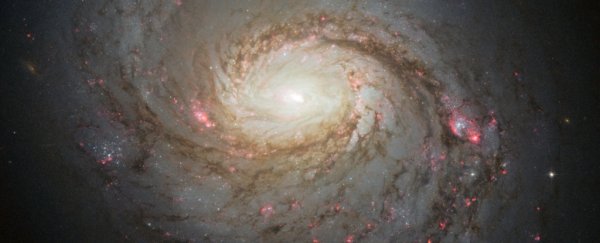In recent years, cosmologists peering back to the very dawn of our Universe have discovered something peculiar. A whole bunch of supermassive black holes - in a time thought way too early for such massive objects to have formed.
Exactly how they got to be so freaking huge so quickly is a heck of a puzzle - but a new surprise discovery might have delivered an answer. The disc of dust and gas around a supermassive black hole is moving in such a way that it's slurping down material faster than it would normally.
That means it's gaining mass faster than expected - which in turn could explain what happened in the earliest days of our Universe.
The location of this anomalous black hole is the heart of a galaxy called Messier 77, or NGC 1068, around 47 million light-years away.
It's a Seyfert galaxy, which means the supermassive black hole at its centre is actively accreting matter from the space around it.
Because of this, the black hole is surrounded by a huge, swirling, doughnut-shaped cloud that, in visible wavelengths, obscures it and the thin disc of material it's slurping up, called the accretion disc. But when you look at the black hole in radio wavelengths, a greater level of detail can be picked out.
That's what a team of astronomers just did, using the Atacama Large Millimeter/submillimeter Array (ALMA) in Chile.
Thanks to this new view, they were able to measure the movement of the gas in the inner orbits of the torus - and they found something unexpected.
 (ALMA (ESO/NAOJ/NRAO), V. Impellizzeri; NRAO/AUI/NSF, S. Dagnello)
(ALMA (ESO/NAOJ/NRAO), V. Impellizzeri; NRAO/AUI/NSF, S. Dagnello)
"Surprisingly, we found two discs of gas rotating in opposite directions," said astronomer Violette Impellizzeri of the National Radio Astronomy Observatory (NRAO).
"Counter-rotating gas streams are unstable, which means that clouds fall into the black hole faster than they do in a disk with a single rotation direction. This could be a way in which a black hole can grow rapidly."
The supermassive black hole at the heart of M77 - aka M77* - is around 15 million times the mass of the Sun, which means its event horizon is over 88 million kilometres (54 million miles) across. But its gravitational influence extends much farther.
According to the team's observation, the inner disc swirling around the black hole (and into it, like water into a drain) starts at about 2 light-years from the black hole, and extends to about 4 light-years. That's rotating one way.
The torus itself extends much farther, from 4 light-years to 22 light-years. It's rotating in the opposite direction.
If this is indeed how black holes grow more quickly, it's really cool. But! It's also raised another huge mystery.
"We did not expect to see this, because gas falling into a black hole would normally spin around it in only one direction," Impellizzeri said. "Something must have disturbed the flow, because it is impossible for a part of the disc to start rotating backward all on its own."
Counter-rotational flows in space are not actually unprecedented. The thing is, though, is that they're usually seen on different scales - galactic scales, where the counter-rotation occurs thousands of light-years away from the galactic centre.
"The counter-rotation always results from the collision or interaction between two galaxies," said astronomer Jack Gallimore from Bucknell University.
"What makes this result remarkable is that we see it on a much smaller scale, tens of light-years instead of thousands from the central black hole."
What the team thinks might have happened is that counter-rotating material fell into the torus from the host galaxy, or a passing counter-rotating satellite dwarf galaxy got sucked in. And, although the orbits are currently stable, the situation is likely a temporary one.
"[It] will change when the outer disc begins to fall onto the inner disc, which may happen after a few orbits or a few hundred thousand years. The rotating streams of gas will collide and become unstable, and the disks will likely collapse in a luminous event as the molecular gas falls into the black hole," Gallimore said.
"Unfortunately, we will not be there to witness the fireworks."
Bummer.
The research has been published in The Astrophysical Journal.
